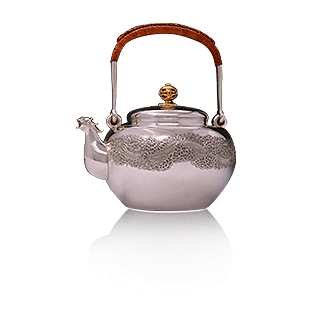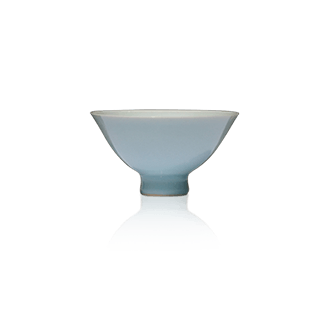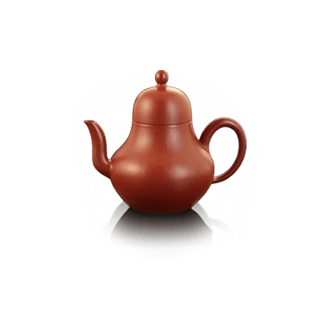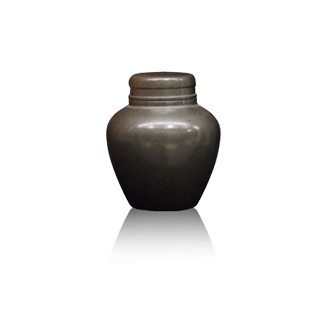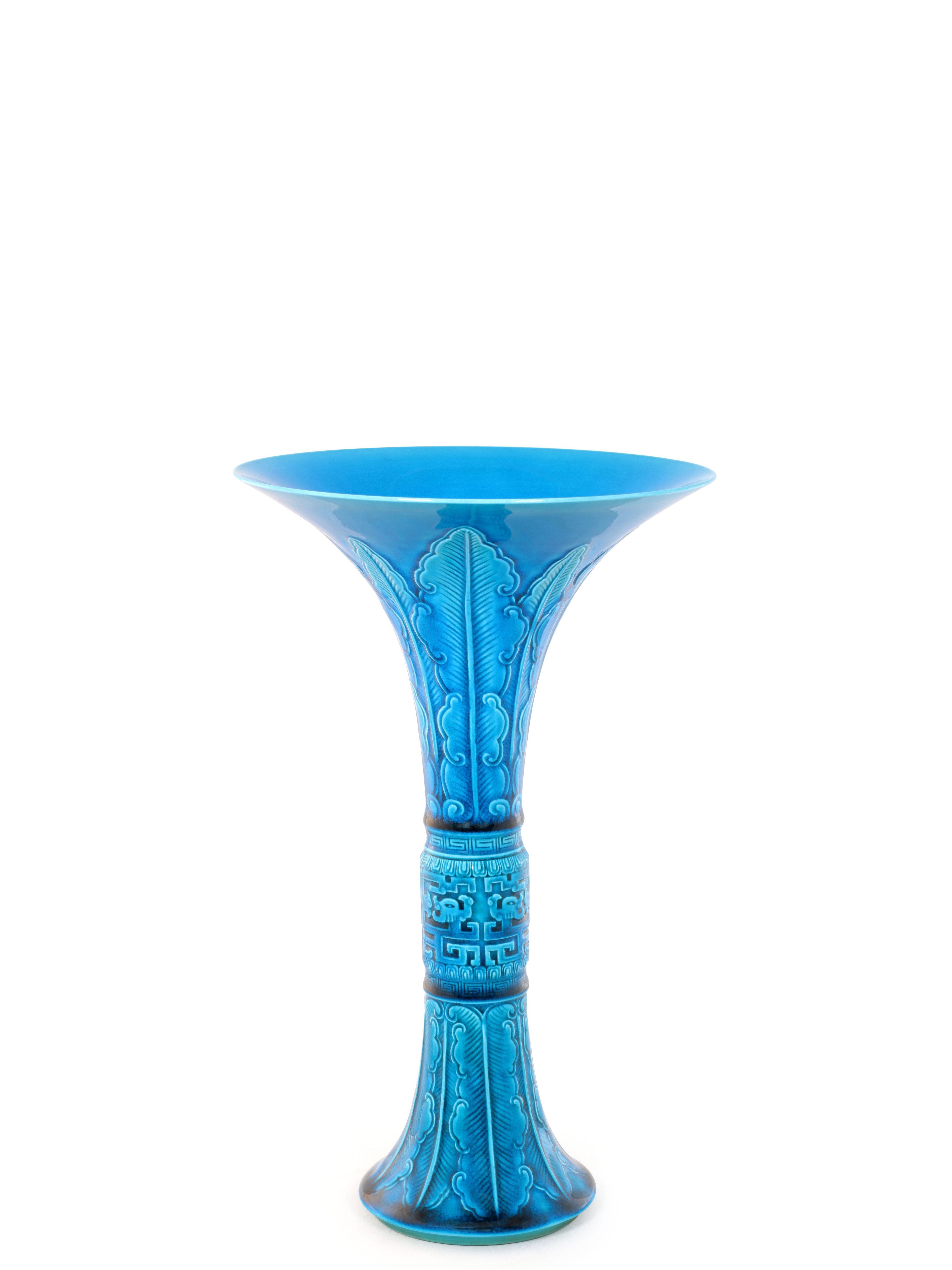

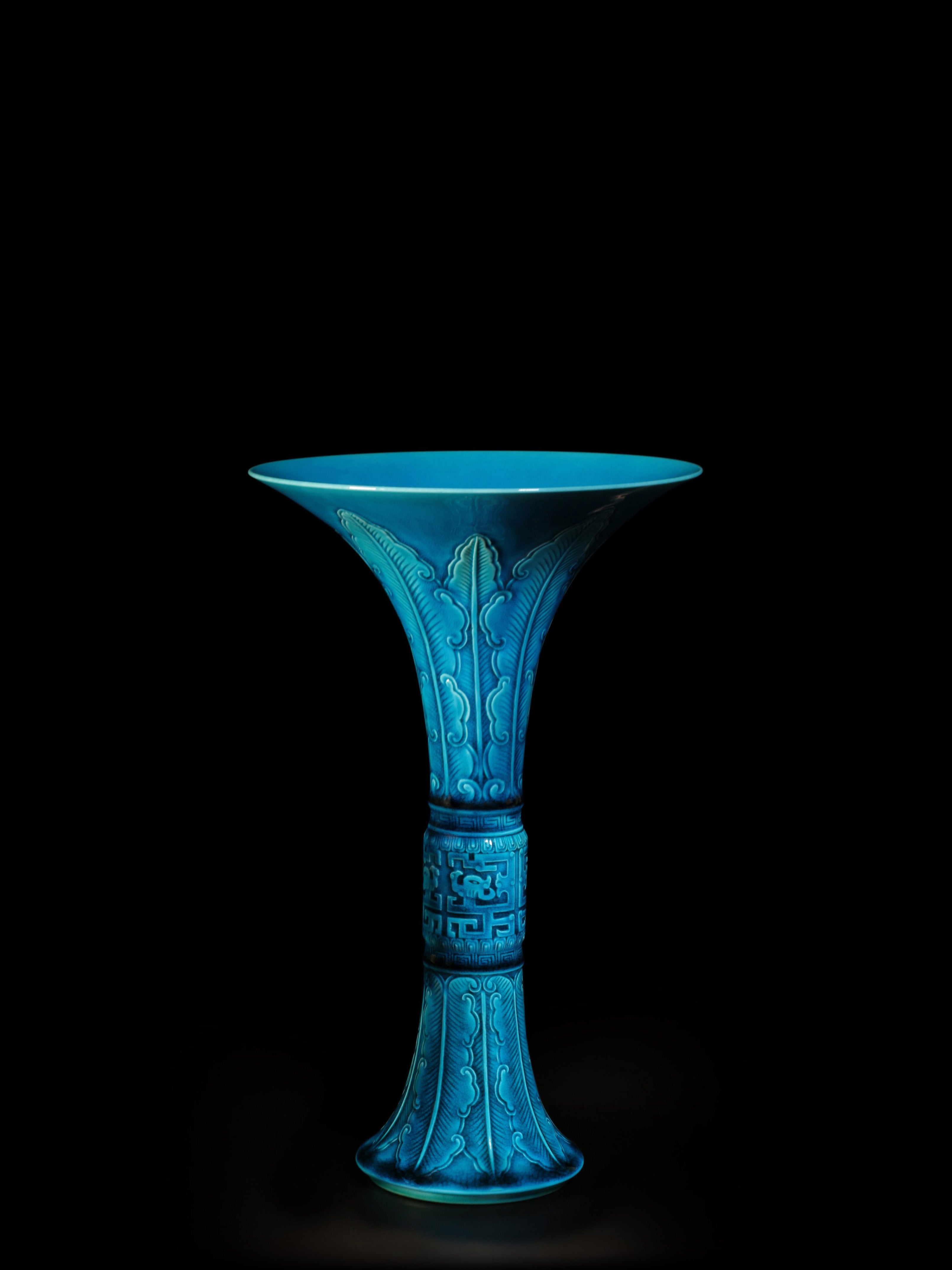
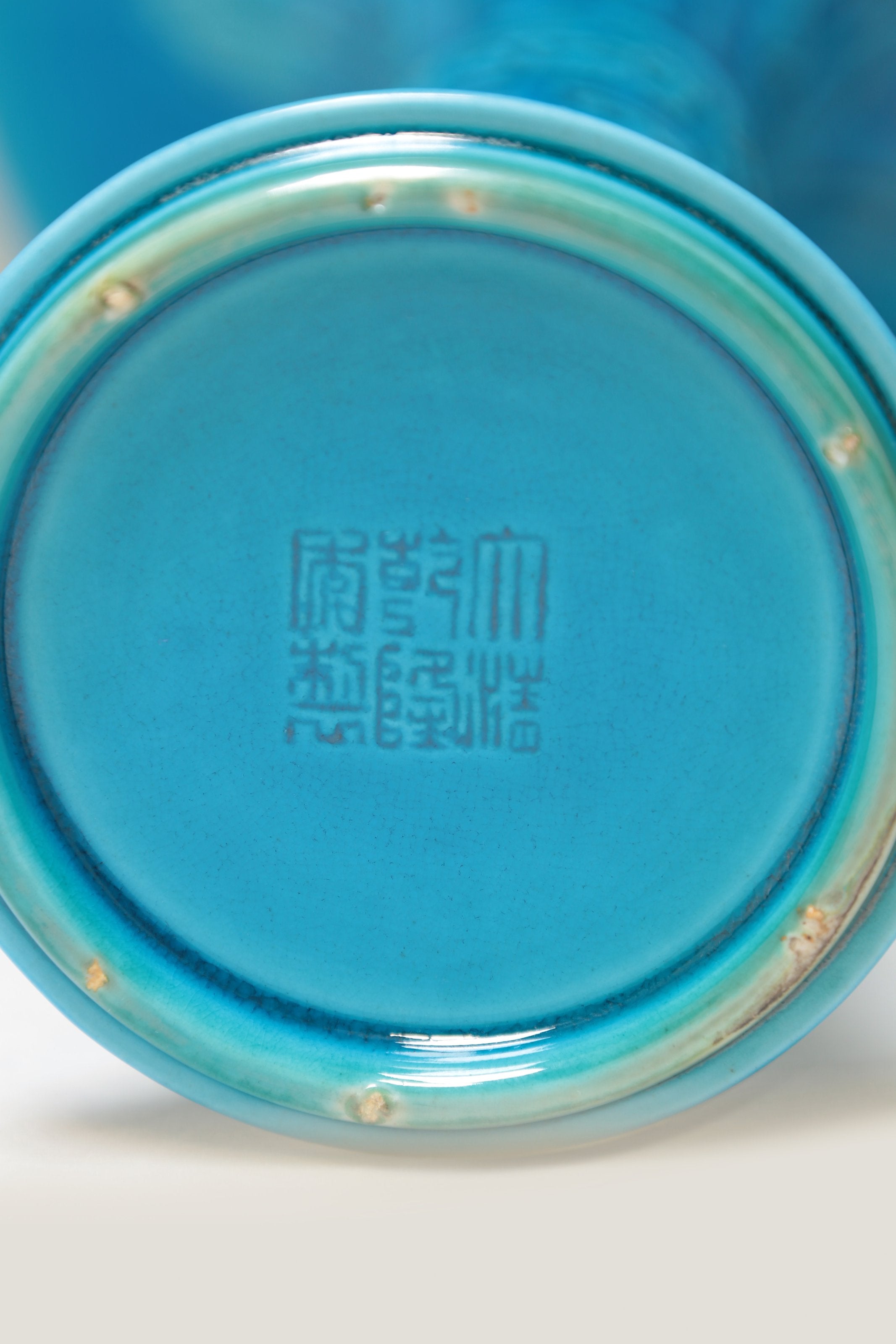




Tu Jinghua's jade-inlaid arched banana leaf and kui pattern gu










Tu Jinghua's jade-inlaid arched banana leaf and kui pattern gu
Tu Jinghua's jade-inlaid arched banana leaf and kui pattern gu
Tu Jinghua's jade-inlaid arched banana leaf and kui pattern gu
Tu Jinghua, inheritor of the intangible cultural heritage of French emerald glaze preparation
The vase is modeled after a pre-Qin bronze vase, with a wide mouth, constricted waist, trumpet shape, and flared foot. The lines are smooth, the neck decorated with banana leaf patterns, the middle of the body with kui dragon patterns, and the base also featuring banana leaf patterns, echoing the rim. The peacock blue glaze is elegant and refined, complementing the beauty of the flowers and leaves. The base bears a six-character seal script mark reading "Made in the Qianlong Reign of the Great Qing Dynasty."
Conical arch, also known as conical flower, is a porcelain decoration technique that involves using a sharp, conical tool to carve fine lines of dragons, phoenixes, flowers, and plants on the surface of the porcelain blank before glazing and firing.
Peacock blue glaze, also known as "French blue," "peacock green," or "jade glaze," uses copper as a colorant, resulting in a bright blue hue after firing. It boasts a magnificent glaze and a rich variety of types. Peacock blue glaze is a traditional glaze color from West Asia. Archaeological discoveries indicate that peacock blue glazed artifacts were introduced to my country, with the earliest traces dating back to three peacock blue glazed pottery bottles unearthed from the tomb of Liu Hua of the Min Kingdom during the Five Dynasties period. China began producing peacock blue glazed artifacts in the Song Dynasty. In the early Ming Dynasty, peacock blue glaze production entered a new phase, involving applying the glaze to a shaped unglazed body and then firing it twice at a low temperature, demanding a high level of skill from the artisans.
Born in 1969 into a ceramic family in Jingdezhen, Tu Jinghua is a representative inheritor of the Jingdezhen intangible cultural heritage—the preparation of Fa Cui glaze. He is also the only inheritor in Jingdezhen who has mastered the preparation, coloring, and firing techniques of medium-temperature Fa Cui glaze.
He began learning the craft from his father in 1987; in January 1989, he joined the Jingdezhen Sculpture Porcelain Factory; in 1996, the company underwent restructuring, and he independently established a ceramic studio specializing in medium-temperature jade glaze decoration materials, which he still runs today.
Apprenticeship: Grandfather Tu Yixin, a late ceramic glaze blending craftsman in Jingdezhen during the Republic of China era (later joined the Ceramic Research Institute of the Ministry of Light Industry);
Apprenticeship: Tu Jincai, father, a veteran craftsman at the Jingdezhen Sculpture Porcelain Factory;
Features:
1) It is made by hand-pouring glaze and adding colors directly onto the unglazed porcelain body and then firing it;
2) The glaze and body are tightly bonded, and the glaze contains fine crackles resembling fish roe.
3) The glaze is bright, thick, warm, elegant and clean, with a strong glassy texture, giving people a pleasing feeling.
Mid-temperature glaze decoration is mainly used for traditional porcelain. In recent years, while working on decorating traditional porcelain with mid-temperature glaze, Tu Jinghua has also been committed to promoting the combination of glaze and modern art porcelain, so that more people can understand glaze.
In 2014, the artwork "Chang'e Flying to the Moon" by Liu Yuanchang, a master of Chinese arts and crafts, was decorated. In the same year, it was also decorated with "The Dawn Ceremony" by Chen Peihuo, an inheritor of provincial intangible cultural heritage. The decorative effect of the colored glazes in the artworks received high praise and recognition from experts.
They also participated in the recording of the large-scale documentary "Craftsmanship in Pottery" about the 72 porcelain-making processes in Jingdezhen, which enabled more people to recognize and understand the medium-temperature jade glaze.
Tu Jinghua, inheritor of the intangible cultural heritage of French emerald glaze preparation
The vase is modeled after a pre-Qin bronze vase, with a wide mouth, constricted waist, trumpet shape, and flared foot. The lines are smooth, the neck decorated with banana leaf patterns, the middle of the body with kui dragon patterns, and the base also featuring banana leaf patterns, echoing the rim. The peacock blue glaze is elegant and refined, complementing the beauty of the flowers and leaves. The base bears a six-character seal script mark reading "Made in the Qianlong Reign of the Great Qing Dynasty."
Conical arch, also known as conical flower, is a porcelain decoration technique that involves using a sharp, conical tool to carve fine lines of dragons, phoenixes, flowers, and plants on the surface of the porcelain blank before glazing and firing.
Peacock blue glaze, also known as "French blue," "peacock green," or "jade glaze," uses copper as a colorant, resulting in a bright blue hue after firing. It boasts a magnificent glaze and a rich variety of types. Peacock blue glaze is a traditional glaze color from West Asia. Archaeological discoveries indicate that peacock blue glazed artifacts were introduced to my country, with the earliest traces dating back to three peacock blue glazed pottery bottles unearthed from the tomb of Liu Hua of the Min Kingdom during the Five Dynasties period. China began producing peacock blue glazed artifacts in the Song Dynasty. In the early Ming Dynasty, peacock blue glaze production entered a new phase, involving applying the glaze to a shaped unglazed body and then firing it twice at a low temperature, demanding a high level of skill from the artisans.
Born in 1969 into a ceramic family in Jingdezhen, Tu Jinghua is a representative inheritor of the Jingdezhen intangible cultural heritage—the preparation of Fa Cui glaze. He is also the only inheritor in Jingdezhen who has mastered the preparation, coloring, and firing techniques of medium-temperature Fa Cui glaze.
He began learning the craft from his father in 1987; in January 1989, he joined the Jingdezhen Sculpture Porcelain Factory; in 1996, the company underwent restructuring, and he independently established a ceramic studio specializing in medium-temperature jade glaze decoration materials, which he still runs today.
Apprenticeship: Grandfather Tu Yixin, a late ceramic glaze blending craftsman in Jingdezhen during the Republic of China era (later joined the Ceramic Research Institute of the Ministry of Light Industry);
Apprenticeship: Tu Jincai, father, a veteran craftsman at the Jingdezhen Sculpture Porcelain Factory;
Features:
1) It is made by hand-pouring glaze and adding colors directly onto the unglazed porcelain body and then firing it;
2) The glaze and body are tightly bonded, and the glaze contains fine crackles resembling fish roe.
3) The glaze is bright, thick, warm, elegant and clean, with a strong glassy texture, giving people a pleasing feeling.
Mid-temperature glaze decoration is mainly used for traditional porcelain. In recent years, while working on decorating traditional porcelain with mid-temperature glaze, Tu Jinghua has also been committed to promoting the combination of glaze and modern art porcelain, so that more people can understand glaze.
In 2014, the artwork "Chang'e Flying to the Moon" by Liu Yuanchang, a master of Chinese arts and crafts, was decorated. In the same year, it was also decorated with "The Dawn Ceremony" by Chen Peihuo, an inheritor of provincial intangible cultural heritage. The decorative effect of the colored glazes in the artworks received high praise and recognition from experts.
They also participated in the recording of the large-scale documentary "Craftsmanship in Pottery" about the 72 porcelain-making processes in Jingdezhen, which enabled more people to recognize and understand the medium-temperature jade glaze.








Frequently asked questions
Use the FAQ section to answer your customers' most frequent questions.
Order
Yes, we ship all over the world. Shipping costs will apply, and will be added at checkout. We run discounts and promotions all year, so stay tuned for exclusive deals.
It depends on where you are. Orders processed here will take 5-7 business days to arrive. Overseas deliveries can take anywhere from 7-16 days. Delivery details will be provided in your confirmation email.
You can contact us through our contact page! We will be happy to assist you.





